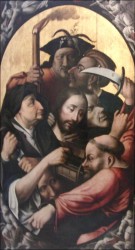
Koldeweij 1995
“Hieronymus Bosch” (A.M. Koldeweij) 1995
[in: A.M. Koldeweij, Van de hoed en de rand… Betekenis en functie van middeleeuwse kunst. Clavis Kleine Kunsthistorische Monografieën – vol. 14, Clavis, Utrecht, 1995, pp. 29-34 (= chapter 5)]
Koldeweij focuses on the left wing of a Passion triptych (Valencia, Museo de Bellas Artes San Pio V) which is attributed to a follower of Bosch (Antwerp, 1530-40). This left wing represents the Arrest of Christ. Koldeweij identifies the man who is carrying a torch at the top of this wing as the apostle James the Greater. The original of the central panel (a Crowning with Thorns) is in the Escorial (since Rotterdam 2001 and the dendrochronological research by Peter Klein it has become clear that this panel is also a sixteenth-century copy). On the trumpet (a Roman lituus) which is being held by a tormentor (in the upper right corner of the Escorial panel), two signs can be seen: a letter H and a star with seven points. In the early sixteenth-century ’s-Hertogenbosch it was obligatory to provide artefacts of precious metal with the city’s trademark (a tree), but also with a master-sign and a year-letter. The H in the Escorial panel refers to the year 1510/11: the year in which the (original) panel was painted?
In the left interior panel of the Valencia triptych St. James is wearing a scallop shell at the edge of his hat (a well-known pilgrim’s insignia in the late Middle Ages referring to Santiago de Compostela), but also a mistletoe, lilies-of-the-valley and three chicken feathers. The mistletoe and lilies-of-the-valley were thought to bring good luck. The chicken feathers can be related to the legend of St. James and more precisely to Santo Domingo de la Calzada, a place of pilgrimage along the Northern Spanish route to Compostela.
[explicit]